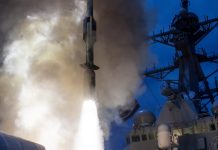The 59th Separate Motorized Infantry Brigade’s staff sergeant shared pictures of Ukrainian soldiers on his Facebook page as Russian forces were routed in the Kherson region. The photo that caught the most attention was of the Su-24M Flanker.
On November 10, Staff sergeant Viktor Zalevsky published photos of Ukrainian tanks, Grad MLRS, a helicopter, and a bomber. However, military observers drew attention to the Su-24M bomber, flying in an unusual gray camouflage.
The plane was photographed in the Kherson region while the battle was in full swing, a Ukrainian language media outlet reported.
A Twitter account, Calibre Obscura, noted that the dark camouflage might indicate that the Su-24M has been removed from storage and inducted into service.
A ridiculously clean Ukrainian Su-24M in black/dark grey colours; evidently a unit returned to service from storage. pic.twitter.com/4WhuGo6KAo
— Cᴀʟɪʙʀᴇ Oʙsᴄᴜʀᴀ (@CalibreObscura) November 13, 2022
According to the Ukrainian media report, the Ukrainian Air Force repaints the sides in a grey pixel camouflage when it modernizes an aircraft.
EurAsian Times could not independently corroborate these claims, but the color code of the Ukrainian Fencer did appear a dark shade of grey or black in the latest picture, as seen in the image.
It is pertinent to note that after the collapse of the erstwhile Soviet Union, Ukraine managed to retain some cutting-edge fighter jets of the time, including the Su-24 Fencer.
While most design bureaus specializing in combat aircraft remained outside of Ukraine, it still had some very skilled maintenance facilities that could update the inherited inventory.
Following some upgrades, the MiG-29MU1, Su-25M1 (and two-seater Su-25UBM1), Su-24M, Su-24MR, and L-39M1 trainers have all gradually returned to service since 2010. Most upgraded airframes and some that were overhauled, not modernized, are camouflaged with a characteristic grey pixel pattern.
Despite being an aging Soviet-era fighter aircraft, the Su-24 has been widely deployed by both combatants. While Russia wields several other cutting-edge fighters, the Ukrainian Air Force has been holding its fort using its Su-24, Su-25, Su-27, and MiG-29 aircraft even after nine months of the conflict.
The outdated Su-24 bombers of the Ukrainian Air Force continue to defy the odds. The air force’s limited number of swing-wing, two-seat bombers has supported the Ukrainian ground troops despite suffering significant losses early in the conflict.
In late October, a MiG-31 equipped with a combination of RVV-BD and RVV-SD missiles shot down one of these Su-24.
Ukraine’s Su-24 Flankers Holding Fort
The Sukhoi Su-24 is a supersonic, all-weather attack aircraft with twin engines, a variable-sweep wing, and side-by-side seating for its two crew members. It was the first aircraft from the USSR to be equipped with a computerized integrated navigation and attack system.
During the conflict’s early months, the Russians downed 11 of the roughly 12 bombers from the 1970s who served in the Ukrainian Air Force.
Some of the Su-24s in long-term storage have been reconditioned and serviced by Kyiv. Up to 47 intact Su-24 airframes were in reserve as of 2015, principally in Bila Tserkva, a city in central Ukraine about south of Kyiv, as previously noted by David Axe, writing for Forbes.
At the end of October, four swing-wing Su-24 Fencer bombers flew in formation over Ukraine, known to be the first in several years. The Ukrainian Air Force lost a dozen of them to Russian attacks in the initial months of the invasion.
Only one tactical aviation brigade based at Starokostyantyniv flew Fencers- Su-24Ms for the strike and Su-24MR for reconnaissance.
However, according to some reports, the Ukrainian Air Force would still have at least 50 Flankers in its arsenal. Therefore, it could be possible that the Air Force, which has now intensified its counter-assault against Russia, would be bringing back Fencers from storage or maintenance facilities to where they belong- in the air!

The swing wings, which Russia also uses in the conflict, provide Ukraine access to a fast-jet precision attack capability that is believed to be conspicuously lacking in the MiG-29 Fulcrum and Su-27 Fencer fighter jets are fielded in huge numbers by the Ukrainian Air Force.
In August, the aircraft was spotted with two air-to-ground missiles mounted on the moving portion of the wing’s outer pylons, which swiveled back and forth. The missiles on the Fencer were the Kh-25ML, also known as AS-10 Karen in the West, and equipped with a semi-active laser seeker.
The Su-24MR reconnaissance jets were being modernized before the invasion, and there were also plans to integrate an air-launched Neptune anti-ship missile on the Su-24M.
However, it is unclear whether these plans materialized. Speculations are rife that Ukraine might equip its Su-24Ms with Storm Shadow missiles and air-launched cruise missiles.
Ukraine has been consistently pleading with the West for modern, cutting-edge western fighter jets like the F-15 and F-16. However, even in their absence, it has been steadily scoring a goal against the Russian Air Force, which has lost more advanced and expensive fighter jets to Ukrainian strikes.
- Contact the author at sakshi.tiwari9555 at gmail.com
- Follow EurAsian Times on Google News





